Search the Blog
Categories
- Books & Reading
- Broadband Buzz
- Census
- Education & Training
- Friday Reads
- General
- Grants
- Information Resources
- Library Management
- Nebraska Center for the Book
- Nebraska Libraries on the Web
- Nebraska Memories
- Now hiring @ your library
- Preservation
- Pretty Sweet Tech
- Programming
- Public Library Boards of Trustees
- Public Relations
- Talking Book & Braille Service (TBBS)
- Technology
- Uncategorized
- What's Up Doc / Govdocs
- Youth Services
Archives
Subscribe
Tag Archives: Friday Reads
Friday Reads: To the Stars Through Difficulties
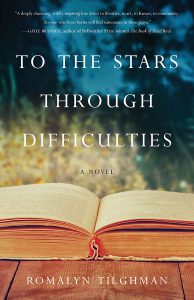 From the author’s website:
From the author’s website:
“To the Stars Through Difficulties (She Writes Press, 2017) is inspired by the fifty-nine Carnegie libraries built in Kansas early in the 20th century.
Andrew Carnegie was the Johnny Appleseed of libraries – but public libraries would never have thrived on the prairie in the early 20th Century if it weren’t for the women in small and remote communities who sponsored waffle suppers, minstrel shows, and women’s baseball games to buy books.
Angelina returns to her father’s hometown of New Hope to complete her dissertation on the Carnegie libraries, just as Traci arrives as artist-in-residence at the renovated Carnegie Arts Center, just when Gayle takes refuge after the devastation of the neighboring town of Prairie Hill by a tornado. Discovery of an old journal provides not only the information Angelina needs to finish her dissertation but also the ammunition to save the Arts Center from attacks by the Religious Righteous and the inspiration for the neighboring and rival town of Prairie Hill to build a cultural center as the first act of reclaiming their lives after the tornado.”
This is definitely a book for library lovers. The history of Carnegie libraries is beautifully interwoven within the story of the present day struggles and triumphs of the libraries/arts/cultural centers of the novel. As a librarian, I of course identified with library school student Angelina. But, the strength, intelligence, and determination of all of the women is inspiring. A very well written, feel-good read … perfect for a relaxing summer vacation or book club discussion.
Want to learn more? Romalyn Tilghman, author of To the Stars Through Difficulties, was on a recent episode of NCompass Live. Check out the archived recording!
Friday Reads: I Am Gandhi: A Graphic Biography of a Hero by Brad Meltzer
As graphic novels have gained popularity and recognition as legitimate reading, authors and illustrators continue to expand into other areas. Although nonfiction told in graphic novel format has been around for  quite some time, it seems in recent years more opportunities have been taken. Well-known nonfiction writer, Brad Meltzer, has created a slim volume the publisher is calling a graphic biography.
quite some time, it seems in recent years more opportunities have been taken. Well-known nonfiction writer, Brad Meltzer, has created a slim volume the publisher is calling a graphic biography.
I Am Gandhi is illustrated by 25 artists, with the variety of art strengthening this excellent biography of an outstanding man. Meltzer tells of his childhood in India, his time spent in London and South Africa, and mentions a particular picture book that influenced his life. It is written as if Gandhi himself is telling of his life to a small group of children. How he developed his non-violent approach, what existing ideas influenced him in its development, and how he and others put it into practice are all included.
This title is a good introduction to Gandhi, his life and beliefs. It may guide readers to look for more in-depth information about him. The timeline, quotes, and photos at the back of the book add to his story.
Librarians may see the title and author and think of his series of biographies for much younger readers, also titled “Ordinary People Change the World.” This younger series is aimed at kindergarten through grade 3 and gives a much briefer look at a number of amazing people.
Meltzer, Brad. I Am Gandhi: A Graphic Biography of a Hero. , 2018. Print.
Posted in Books & Reading, General
Tagged #FridayReads, Brad Meltzer, Friday Reads, graphic novel, I Am Gandhi
Leave a comment
Friday Reads: I’ll Be Gone in the Dark by Michelle McNamara
 Sometimes a book in your read-me-next list jumps to the front of the pack. I read the news reports like everyone else, a month ago, April 25, 2018—the Golden State Killer had finally been arrested. Over thirty years since his last likely murder, authorities arrested a suspect, 72-year-old Sacramento resident Joseph James DeAngelo, a former police officer, based on DNA evidence. I thought to myself: it’s time to read that book by Michelle McNamara, before I read anything else.
Sometimes a book in your read-me-next list jumps to the front of the pack. I read the news reports like everyone else, a month ago, April 25, 2018—the Golden State Killer had finally been arrested. Over thirty years since his last likely murder, authorities arrested a suspect, 72-year-old Sacramento resident Joseph James DeAngelo, a former police officer, based on DNA evidence. I thought to myself: it’s time to read that book by Michelle McNamara, before I read anything else.
I’ll Be Gone in the Dark: One Woman’s Obsessive Search for the Golden State Killer chronicles McNamara’s tireless research into the then-cold case of the serial killer (and rapist and burglar) that she dubbed the Golden State Killer, a moniker now solidified by recent media attention. While I’m not a true-crime buff, I am a lover of research and storytelling and problem-solving, and McNamara’s journey is thoughtfully told, somehow incredibly informative without ever being lurid or sensational. She never exploits or re-victimizes the people who had the misfortune to experience the mystifying, seemingly random violence of the Golden State Killer. The events in the book are not detailed chronologically from the Killer’s perspective, either, which would be more expected. This structure of the presentation of events seems to de-center and deflate the Killer, which is poetic, considering his need for control. Truly, this book is not really about him.
We read about his crimes in different geographic areas of law enforcement, between 1974 and 1986, and how different agencies put together that the crimes in their area might be committed by one offender. And then, occurring much later, we read how investigators realized how all these offenders (the East Area Rapist, the Original Night Stalker, the Visalia Ransacker, etc.) might be one extremely prolific criminal, that we now know as the Golden State Killer. McNamara details the protocols of investigations, and how they were changing, especially related to DNA collection and testing. She also did copious research herself, and interviews other researchers, amateur and professional, for a fascinating look into the minds of those who try to solve crimes.
McNamara died before she could complete the book. I didn’t know much about her or her writing career before she died. I was familiar with the work of her husband, Patton Oswalt, having enjoyed reading his books and watching his stand-up routines. McNamara was well-known in true crime circles for her blog TrueCrimeDiary, which focused on—you guessed it—true crime and cold cases, an interest she had ever since the unsolved murder of a teenager in her neighborhood as a child. When she died unexpectedly in 2016, McNamara had mostly completed the book, and had written many articles about the case and made extensive notes. The book was completed, faithful to its original intent, by a true crime writer she had worked with previously (Paul Haynes) and Oswalt. The editors have made it very clear what was written by her, what was transcribed from her notes and recordings, what was adapted from her published articles, and so on.
The book was released in February 2018, and it was the story of its posthumous publication that attracted me to it at first. Then HBO purchased the rights, and I was even more interested. And you already know what happened on April 25, 2018.
The title sounds like an odd choice, but when you read the chapter it comes from—a letter McNamara wrote to the Killer, about his eventual capture that she was certain would occur, written long before April 25,, 2018—you’ll understand why it was chosen for the title.
Of interest to library workers: using WorldCat as a research tool, on p 269, in a chapter called “The One.” In this engrossing chapter, we read about the “one” suspect on which various investigators each fixated, how they were each sure they had finally figured out who their suspect was, and then how all the different “ones” were ruled out. (Sidney, Nebraska is also mentioned on p 269—but don’t worry, just read the chapter.)
Also of interest to Nebraskans: the epigraph is a poem by Weldon Kees, “Crime Club.” It helps set an eerie tone for a book as much about the people solving a crime as it is about crime or a criminal. Sure, after you finish the book, you’ll probably want to dive into the news reports about Joseph James DeAngelo. (There’s plenty to read about him already, and more will come out when we get closer to a trial.)
But you might also take a little time to appreciate Weldon Kees. And look into the mystery of his disappearance, if you choose. Or just enjoy some of his poetry.
McNamara, Michelle. I’ll Be Gone in the Dark: One Woman’s Obsessive Search for the Golden State Killer. , 2018. Print.
Friday Reads: Moon by Alison Oliver
 Moon is overwhelmed with homework, music lessons, soccer practice, chores, and stuff. Every single day is the same.
Moon is overwhelmed with homework, music lessons, soccer practice, chores, and stuff. Every single day is the same.
But she wonders how it could be if she just didn’t have to do these things.
Following a shooting star and some paw prints into the forest, Moon meets a wolf who, along with his pack, shows her their “wolfy ways” – how to play, how to be still, and how to be wild.
Moon, written and illustrated by Alison Oliver (2018), is a sweet story with beautiful, expressive pictures about balancing the day-to-day busy schedules with time spent outside, playing and connecting.
Friday Reads; The Woman in Cabin 10, by Ruth Ware
In Ruth Ware’s The Woman in Cabin 10, it’s the old set up on a cruise ship, there’s a lady in a cabin, but she isn’t really there. There were sounds of a struggle, and a body hitting the water, a smear of some substance on a privacy screen like blood, but in the morning, nothing. The night before there had been suitcases, and clothing in the cabin. In the morning it is completely bare
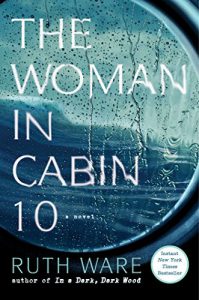
The Woman in Cabin 10
Lo (Laura) Blacklock wouldn’t have heard the sounds from the cabin next door, except, within days of the trip, her flat in London was broken into while she slept. The burglar actually locked her in her bedroom while he burgled her flat. She’s gone through the trouble of replacing her phone, money and credit cards, but the break in has deeply disturbed her. To top it all off, she’s had a fight with her boyfriend, a photojournalist just back from a foreign shoot. She’s sleep deprived. anxious, and now, can’t find the mysterious young woman, approximately her age, who she borrowed mascara from in cabin 10 next door. Worse, none of the crew or passengers are missing.
But this time, the cruise ship, the cruise, and the passengers are all rather unique. It’s a very, very small, very exclusive cruise ship, more like a large yacht. Fitted out sumptuously, with guests to both fit the setting, and to advertise it–a few of the rich, the owner and his dying wife, travel journalists, a renowned photographer, all to advertise the maiden voyage of the Aurora Borealis, as it sets off from London to sight see the fjords of Norway, cities of the cold northern waters, as well as watch the Northern Lights. And Lo has gotten the chance of a lifetime to go, instead of the owner/head writer of the travel magazine she works for.
On top of the regular narrative are inset emails and online conversations from family and friends unable to contact Lo, foreshadowing a darker, more personal fate for Lo. It all works together to come to an altogether unexpected series of twists. The book is definitely a page turner, as Lo gets herself into trouble taking us right with her.
The Woman in Cabin 10, a novel, by Ruth Ware, Scout Press, imprint of Simon & Schuster, Inc., hardcover 9781501132933, softcopy 9781501132957, e-book 9781501132940
Posted in Books & Reading
Tagged Friday Reads
Comments Off on Friday Reads; The Woman in Cabin 10, by Ruth Ware
Friday Reads: The Archivist, by Martha Cooley
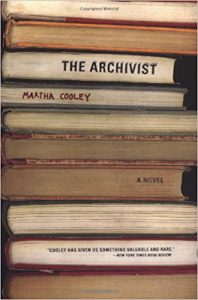 Matthias Lane is a library archivist, a widower nearing retirement at an American university, who guards the rules of the library’s archives religiously. Case in point—the archives has among its’ collections the letters written by T.S. Eliot to Emily Hale, a close personal friend. Graduate student Roberta Spire wants access to those letters, but the instructions left when the letters were donated do not allow public viewing until the year 2020. Roberta believes that the letters will give insight into why Eliot enjoyed female companionship, but was so emotionally detached from his wife, as well as to why Eliot became religious. At first, Matthias sees Roberta as only another grad student doing research. But as Roberta persists in wanting to read Eliot’s letters, Matthias is intrigued by her persistence, and by her knowledge of Eliot’s life and poetry that matches his own. As Matthias gets better acquainted with Roberta, he begins to realize that his own life and marriage are similar to Eliot’s, which Matthias has not previously examined in depth. As a result, his dilemma over Eliot’s letters ends in a completely unexpected solution.
Matthias Lane is a library archivist, a widower nearing retirement at an American university, who guards the rules of the library’s archives religiously. Case in point—the archives has among its’ collections the letters written by T.S. Eliot to Emily Hale, a close personal friend. Graduate student Roberta Spire wants access to those letters, but the instructions left when the letters were donated do not allow public viewing until the year 2020. Roberta believes that the letters will give insight into why Eliot enjoyed female companionship, but was so emotionally detached from his wife, as well as to why Eliot became religious. At first, Matthias sees Roberta as only another grad student doing research. But as Roberta persists in wanting to read Eliot’s letters, Matthias is intrigued by her persistence, and by her knowledge of Eliot’s life and poetry that matches his own. As Matthias gets better acquainted with Roberta, he begins to realize that his own life and marriage are similar to Eliot’s, which Matthias has not previously examined in depth. As a result, his dilemma over Eliot’s letters ends in a completely unexpected solution.
This book appealed to me on two levels: it was a story involving a library archives, and a story based in historical fact. The letters of T.S. Eliot to Emily Hale are real, and are kept in the Firestone Library, at Princeton University. The letters are not to be shown to the public until January 1, 2020.
The Archivist, by Martha Cooley, was written 20 years ago, it was is still a great read, and I highly recommend it.
Friday Reads: Night School by Lee Child
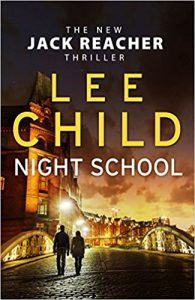 A member of my book group recently had us read Night School, the 21st entry in Lee Child’s very successful Jack Reacher series. While I’ve often felt it can be more difficult to have good conversations about genre titles, I’m happy to report we found plenty to discuss.
A member of my book group recently had us read Night School, the 21st entry in Lee Child’s very successful Jack Reacher series. While I’ve often felt it can be more difficult to have good conversations about genre titles, I’m happy to report we found plenty to discuss.
If you are a Lee Child reader, you know that the books feature Jack Reacher – a loner, drifting from place to place after mustering out of the Army in 1997 with the rank of Major. He does not own a home, possess a driver’s license, or collect federal benefits. The only item typically in his possession is a toothbrush and he never carries luggage of any sort. In Night School, Child resets the clock and places Reacher back in the army as a military policeman – part of the fictional 110th Special Investigations Unit formed to handle exceptionally difficult cases. The book begins with Reacher receiving an award for completing a successful covert operation in the morning, and by the afternoon, he’s reporting to night school.
His classmates include an FBI agent and a CIA analyst, both of whom also recently completed successful covert operations. Wondering what this school is about they receive the following background briefing: “[A] Jihadist sleeper cell in Hamburg, Germany, has received an unexpected visitor—a Saudi courier, seeking safe haven while waiting to rendezvous with persons unknown. A CIA asset, undercover inside the cell, has overheard the courier whisper a chilling message: The American wants a hundred million dollars.” From here, we follow Reacher and his classmates trying to determine what could be worth a hundred million dollars.
On the Lee Child website, I found an article by Stav Sherez entitled “Five reasons why the Jack Reacher novels are brilliant.” The fact is that even though the books are hugely popular, they often fail to garner much critical respect –as is often the case with series, genre books. The most discussable point of the article for me was that “…the Reacher books are Westerns in disguise and this goes a long way to explaining why they are so phenomenally popular…. Reacher is the classic silent stranger who rides into town and saves the small folk from rapacious bullies.” I would have never thought of Child’s books as westerns, but endings where justice is served are always satisfying.
I asked my group if reading this series in order was essential and the answer was no. Each book could be a standalone because each is uniquely episodic and Reacher’s personal life does not change or progress dramatically from title to title. Similarly, plots for the Jack Reacher movies starring Tom Cruise have been cherry picked from the series based on those most suitable for cinema (One Shot #9 and Never Go Back #18), as opposed to series order. We also discussed why people read series (and why some do not) and overwhelmingly series reader do not want to leave the character when others are perfectly happy to do so. When I asked if Jack Reacher could be someone they knew, all of the readers of the series said – he is real to me. As long as Lee Child continues to write, Jack Reacher remains safely in our group of literary friends.
Child, Lee. Night School. New York: Delacorte Press, 2016
Friday Reads: Tana French
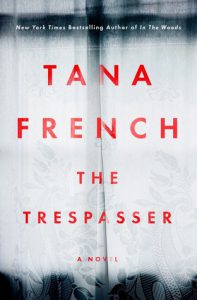 Reading a Tana French novel is like taking a trip to Dublin, Ireland. Like Maeve Binchy, French manages to capture not only the spirit of this city, but its people as well. While French’s novels focus on detectives from Dublin’s murder squad, these are not your classic police procedural mysteries. Rather, they focus on an ever-changing group of wonderfully complicated characters, full of contradictions, whose personal lives are delightfully messy. The victims, themselves, are equally interesting as well. Like the detectives who investigate their murders, their lives are complex and marked with many question marks. Rarely does the story travel in a straight line, but rather zigs and zags until the final page.
Reading a Tana French novel is like taking a trip to Dublin, Ireland. Like Maeve Binchy, French manages to capture not only the spirit of this city, but its people as well. While French’s novels focus on detectives from Dublin’s murder squad, these are not your classic police procedural mysteries. Rather, they focus on an ever-changing group of wonderfully complicated characters, full of contradictions, whose personal lives are delightfully messy. The victims, themselves, are equally interesting as well. Like the detectives who investigate their murders, their lives are complex and marked with many question marks. Rarely does the story travel in a straight line, but rather zigs and zags until the final page.
Currently, there are six novels in French’s Dublin Murder Squad series: In the Woods (2007), The Likeness (2008), Faithful Place (2010), Broken Harbor (2012), The Secret Place (2014) and The Trespasser (2016). All take place in Dublin, or the surrounding area. All take place within a short period, usually no more than over the course of a few weeks.
Unlike other series, such as the Kay Scarpetta books by Patricia Cornwell or Elizabeth  George’s Inspector Lynley novels, French focuses each book on a different character. Some characters, such as Frank Mackey and Mick “Scorcher” Kennedy appear in several books. Others, like Rob Ryan from In the Woods, vanish as soon as their story concludes. That said, each title can be read in no particular order without feeling as though you’ve missed something along the way.
George’s Inspector Lynley novels, French focuses each book on a different character. Some characters, such as Frank Mackey and Mick “Scorcher” Kennedy appear in several books. Others, like Rob Ryan from In the Woods, vanish as soon as their story concludes. That said, each title can be read in no particular order without feeling as though you’ve missed something along the way.
Ultimately, French spins terrific tales of suspense and intrigue. Her stories are not always pretty. Often, in their rush to solve a murder, French’s characters reveal their deepest and darkest secrets. Instead of making them unlikeable, it makes them relatable. After all, we all have our secrets.
Friday Reads: The Line Becomes A River: Dispatches from the Border, By Francisco Cantu
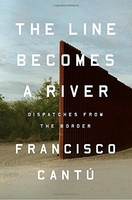 Francisco Cantu brings a unique perspective to his debut book, The Line Becomes A River, a nuanced exploration of the United States-Mexican border. In addition to being a third-generation Mexican-American who grew up near the border, Cantu studied international relations and border policy at American University, in Washington, D.C. After graduating with honors, he served in the United States Border Patrol from 2008 to 2012, working in Arizona, New Mexico, and Texas. More recently, in 2016, he earned an MFA in Nonfiction from the University of Arizona.
Francisco Cantu brings a unique perspective to his debut book, The Line Becomes A River, a nuanced exploration of the United States-Mexican border. In addition to being a third-generation Mexican-American who grew up near the border, Cantu studied international relations and border policy at American University, in Washington, D.C. After graduating with honors, he served in the United States Border Patrol from 2008 to 2012, working in Arizona, New Mexico, and Texas. More recently, in 2016, he earned an MFA in Nonfiction from the University of Arizona.
Given Cantu’s background and experience, he could have taken this book in many different directions; the route he chose, however, is that of a deeply personal memoir, described by reviewers as “heartfelt,” “lyrical,” “intimate,” “brutal,” and “heartbreaking.” It unfolds in three unnamed parts. Part one opens with Cantu attending training at the Border Patrol Academy, and it follows him during his initial field placements. While it includes numerous accounts of Cantu’s experiences with border crossers and fellow agents, part one is notably framed by two conversations with his mother, which establish the moral conflict at the heart of the entire narrative.
The first conversation occurs when Cantu is still in training at the academy. During her Christmas visit, Cantu’s mother struggles to understand why he wants to join the Border Patrol, which she refers to as “a paramilitary police force.” He responds: “I’m tired of studying, I’m tired of reading about the border in books. I want to be on the ground, out in the field . . . I don’t see any better way to truly understand the place.” His mother is clearly not convinced and is obviously worried about more than just his physical safety: “There are ways to learn these things that don’t put you at risk, she said, ways that let you help people instead of pitting you against them.”
The second conversation occurs at the end of part one, during a subsequent Christmas visit. When his mother asks if he likes the work and is learning what he wanted, he’s not up to having the conversation he knows she’s trying to initiate. And when she brings up “how a person can become lost in a job, how the soul can buckle when placed within a structure,” he cuts her off: “I was too exhausted to consider my passion or sense of purpose, too afraid to tell my mother about the dreams of dead bodies and crumbling teeth, . . . about my hands shaking at the wheel.”
By part two, Cantu has been promoted to doing intelligence work, first in Tucson, then in El Paso. Though he continues to recount his own experiences, his narrative increasingly focuses on the systemic violence haunting both sides of the border: the beheadings, massacres, and mass graves tied to drug cartels; and the kidnapping and ransoming of desperate border crossers by organized smuggling gangs capitalizing on stricter border enforcement. His teeth are a mess from constant grinding and his nightmares persist.
The narrative’s emotional climax occurs during part three. By this time, Cantu has quit the Border Patrol and returned to school, leaving his most intense stress behind. But completely outrunning the emotional trauma of border enforcement proves impossible. This time it affects Cantu personally, when agents detain his undocumented friend, Jose, who is trying to reenter the United States after visiting his dying mother in Mexico. Suddenly, Cantu is experiencing border enforcement from the perspective of the detainee, and the detainee’s family and friends. He does what he can to help Jose navigate the immigration and court systems, but current policies offer little recourse and his friend is deported.
In the third and final Christmas conversation with his mother, Cantu shares the pain, hurt, and conflict he feels over Jose’s situation: “I don’t know what to do, I confessed. I feel pain, I feel hurt, but it isn’t mine. . . . It’s like I never quit . . . It’s like I’m still a part of this thing that crushes.” His mother responds: “You can’t exist within a system for [four years] without being implicated, without absorbing its poison. . . So what will you do? All you can do is try to find a place to hold it, a way to not lose some purpose for it all.”
One gets the feeling this memoir—dedicated in part “to all those who risk their souls to traverse or patrol an unnatural divide”—may be one manifestation of Cantu’s effort to follow his mother’s advice.
Cantu, Francisco. The Line Becomes a River: Dispatches from the Border. New York: Riverhead, 2018.
Friday Reads: The Woman in the Window by A. J. Finn
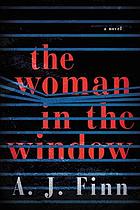 A. J. Finn’s The Woman in the Window is a whodunit thriller with lots of surprises and unexpected outcomes. The book has been likened to Paula Hawkins’ The Girl on the Train and Gillian Flynn’s Gone Girl and with elements of a Hitchcock movie.
A. J. Finn’s The Woman in the Window is a whodunit thriller with lots of surprises and unexpected outcomes. The book has been likened to Paula Hawkins’ The Girl on the Train and Gillian Flynn’s Gone Girl and with elements of a Hitchcock movie.
Anna Fox, a psychologist in her late 30s, is the protagonist. Anna lives alone in an upscale Manhattan home. A young carpenter is a tenant who occupies the basement. The reader soon learns that Anna is agoraphobic and has not left her home during the past year. While living alone she has frequent phone conversations with her husband and 8-year-old daughter who are supposedly living elsewhere. Much of Anna’s time is spent watching black and white movie classics. Home bound, Anna observes her neighborhood and neighbors from her living room window. It is there that she witnesses, from a distance, a violent act in a home occupied by a family new to the neighborhood.
Anna’s fear of leaving her home, her aloneness and depression contribute to excessive drinking with wine as her favored drink. Her drinking, mixed with prescription drugs, compromises her credibility when she reports the incident to the police. Is she delusional? The conflict grows from there among Anna, the new and troubled neighbors, the police, and even her tenant. And there is Anna’s past – how did she become agoraphobic? What’s the story behind the absence of her husband and daughter?
The Woman in the Window is A. J. Finn’s first novel and a best seller from the get go. Though, not surprising because Finn (a pseudonym) is Dan Mallory, an experienced executive mystery fiction editor for William Morrow, the books publisher.
Finn, A J. The Woman in the Window. HarperCollins, 2018. Print.
Posted in Books & Reading
Tagged "The Woman in the Window", #FridayReads, A.J. Finn, Fiction, Friday Reads, Novel
Leave a comment
Friday Reads: Twin Peaks: The Final Dossier
 Last year saw the brilliant return of Twin Peaks season 3 on Showtime. For those of you who haven’t seen season 3 yet, I highly recommend it. However, it would be beneficial for you to review the first 2 seasons, which originally aired in 1990 and 1991. Yep, that’s correct, I’m recommending a TV series from the 90’s. Your local library or inter-library loan service should be able to net you the DVD’s (including season 3). A prequel movie, called Twin Peaks: Fire Walk With Me, is also beneficial before you swan dive into season 3. But today’s write up is about Twin Peaks: The Final Dossier, and not Twin Peaks the video series. While the author of the Final Dossier is Twin Peaks co-creator Mark Frost (the other co-creator is David Lynch), the book is written as a series of final FBI reports from the perspective of season 3 special agent Tammy Preston. I was surprised at the depth of Tammy’s reports. While I found Tammy’s character in season 3 to be a bit aloof (to put it mildly), not so in the case of the Final Dossier. She comes across as thorough, to the point, and witty in a Twin Peaks sort of way which is to say quite unconventional and refreshing.
Last year saw the brilliant return of Twin Peaks season 3 on Showtime. For those of you who haven’t seen season 3 yet, I highly recommend it. However, it would be beneficial for you to review the first 2 seasons, which originally aired in 1990 and 1991. Yep, that’s correct, I’m recommending a TV series from the 90’s. Your local library or inter-library loan service should be able to net you the DVD’s (including season 3). A prequel movie, called Twin Peaks: Fire Walk With Me, is also beneficial before you swan dive into season 3. But today’s write up is about Twin Peaks: The Final Dossier, and not Twin Peaks the video series. While the author of the Final Dossier is Twin Peaks co-creator Mark Frost (the other co-creator is David Lynch), the book is written as a series of final FBI reports from the perspective of season 3 special agent Tammy Preston. I was surprised at the depth of Tammy’s reports. While I found Tammy’s character in season 3 to be a bit aloof (to put it mildly), not so in the case of the Final Dossier. She comes across as thorough, to the point, and witty in a Twin Peaks sort of way which is to say quite unconventional and refreshing.
The Final Dossier focuses on some rather interesting things about the Twin Peaks townspeople, and specifically what’s happened to them over the past 25 years (the gap between seasons 2 and 3). These people include Shelley Johnson and Co., the Haywards, the Horne’s, the Hurley’s, Windom Earle, Dr. Jacoby, Harry, and Annie. I’m sure I’ve missed some. I’d say it was interesting to read more about these characters, but the ultimate question after watching the ending of season 3 is: What really happened? The Final Dossier does in fact shed some light on these philosophical tidbits, and confirms some thoughts and theories by including dossiers devoted to Major Briggs, Philip Jeffries, Judy, the log lady, and in a roundabout way other big league players such as the Fireman, BOB, and the Woodsmen. Cooper (both good Coop and evil Coop/Mr. C) and Diane are also spread throughout both of these narratives. Be prepared, as these things — both the book and TV series — include various dimensions, the supernatural, doppelgangers, alternate timelines and realities, and the omnipresent dream, which we may or may not live inside of. Or do we live inside of a dream of a dream? And as Twin Peaks asks, who is the dreamer?
Moving forward from that, I find it helpful to offer a brief sample so the reader of the review can get a flava for the writing style. In this case, thumbs up goes to this one:
“And even as we ‘wonder’ at what we’re doing here, so do we also fear – so deep down below the surface of our lives that few can bear to look at it – that life is a meaningless jest, an extravagant exercise in morbidity, a tale of sorrow and suffering lit by flashes, and made bearable only by moments of companionship and unsustainable joy. Along the way, as we struggle to come to terms and comprehend why this strange fate has befallen us, time becomes no longer our ally – the spendthrift assumption of our youth – but our executioner. It all feels at times like a merciless joke made at our expense, without our consent.”
While I’m now tempted to swing by the local library, grab some Sarte, head home and crank up some Joy Division on my home Hi-Fi, I think I’ll resist those urges. A final thought on the season 3 series that sums up its originality is evidenced by this brief video. And if that doesn’t make you want to watch the series or read the book, I don’t know what would. Maybe it just isn’t for you. But if it is, let me know so we can talk about theories, and we can certainly talk about Judy. Season 3 on DVD is now available.
Frost, Mark. Twin Peaks: The Final Dossier. New York: Flatiron Books, 2017. Print.
Friday Reads: “The Nightingale: A Novel” by Kristin Hannah
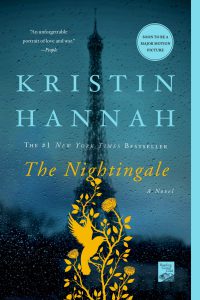 This is a story of two sisters at the beginning of World War II, who each try to find their own way of responding to the horror that is war lived up close and personal on your own turf. The question is posed: “Oh, for heaven’s sake, Isabelle. Paris is overrun. The Nazis control the city. What is an eighteen-year-old girl to do about all of that?” The answer is very different for the two sisters (and for all the characters in the book), but the story that unfolds of their struggle for survival under Nazi rule answers that question with a moving and fascinating tale.
This is a story of two sisters at the beginning of World War II, who each try to find their own way of responding to the horror that is war lived up close and personal on your own turf. The question is posed: “Oh, for heaven’s sake, Isabelle. Paris is overrun. The Nazis control the city. What is an eighteen-year-old girl to do about all of that?” The answer is very different for the two sisters (and for all the characters in the book), but the story that unfolds of their struggle for survival under Nazi rule answers that question with a moving and fascinating tale.
The Amazon.com book blurb begins with: “With courage, grace, and powerful insight, bestselling author Kristin Hannah captures the epic panorama of World War II and illuminates an intimate part of history seldom seen: the women’s war.” I loved this book, but I’m not sure I agree with the previous statement. It seems to me that the women’s war has been featured recently in a number of excellent books, AND I have to say I do appreciate that. So I wondered what this book would bring to the narrative that hasn’t already been exposed in one of those books. One thing I discovered is that this book is based on a true story. One of the sisters is based on a real-life war hero of the French Resistance, a French woman who led Allied flyers to safety on foot over the Pyrenees Mountains.
The relationship between the sisters is far from perfect and that tension helps the reader understand that one casualty of war can be the time and space to work things out with the ones we love. The author says, “The characters in The Nightingale are each confronted with incredible, terrifying choices. In love and in war, each character will find out who they really are.” A challenge that I experienced in reading this book is that the reader is called to evaluate the results of these choices and to examine choices that we might make under the same circumstances—maybe to find out who we really are.
Read this award-winning book now before it shows up in the movie theatres. The Internet is abuzz with speculation about who will star in the upcoming film. The picture, directed by Michelle MacLaren (Game of Thrones and Breaking Bad), is set for release August 10, 2018. The film adaptation of the novel is written by Ann Peacock (Chronicle of Narnia: The Lion, The Witch And The Wardrobe), with MacLaren and John Sayles on board to polish the draft.
The Nightingale: A Novel by Kristin Hannah (St. Martin’s Griffin, 2017)
Review by Mary Jo Ryan
#FridayReads
Friday Reads: Greetings From Witness Protection by Jake Burt
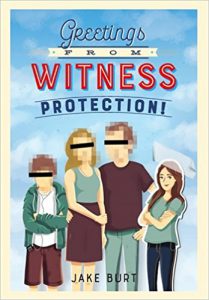 Do you ever dream about starting over? Leaving your old life behind, assuming a new identity and becoming a whole other person?
Do you ever dream about starting over? Leaving your old life behind, assuming a new identity and becoming a whole other person?
Elena Sicurezza was a lawyer for a notorious crime family, the Cercatores. After testifying against the mob, she and her husband and son are placed into witness protection. The U.S. Marshals decide adding a daughter to the family will make them harder to find – after all, the mob is looking for 3 people, not 4. Enter Nicki Demure.
13 year old Nicki is in-between foster families, a ward of the state after her father went to prison and her grandmother passed away. As hard as she tries, she just can’t seem to stick with any one foster placement – partially because she has a smart mouth and a bad habit of picking pockets, and also because she just knows her father will come for her as soon as he is paroled. But… Nicki learns that he has been released from prison and still hasn’t shown up… two years later. So when a federal marshal offers her the chance to join a family going into hiding, she takes the plunge.
So the Sicurezza family of New York become the Trevors of Ohio, and Nicki is transformed into their daughter Charlotte. The family is placed in North Carolina, where they try to lay low.
Pick up this middle grade novel to see how Nicki/Charlotte handles Southern-belle mean girls, visits from gangster henchmen, and a new brother who is loathe to give up his only-child status. If you enjoy humorous realistic fiction, you’ll love this story as much as I did!
Burt, Jake. Greetings From Witness Protection. Feiwel & Friends, 2017. Print.
Friday Reads: The 12 Dares of Christa
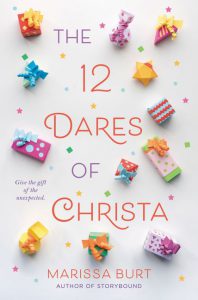 Confession #1: Yes, I read this book because it had my name in the title. I had no idea what it might be about, but I just had to check it out.
Confession #1: Yes, I read this book because it had my name in the title. I had no idea what it might be about, but I just had to check it out.
Confession #2: I liked it!
The 12 Dares of Christa is the most recent YA novel by Marissa Burt. It’s a funny, sad, heartwarming story of a teen girl working through a difficult, confusing time in her life.
Christa is a huge fan of the holidays, and each year the planning starts months in advance. She loves to come up with a crazy agenda of activities for her and her parents. This year is different though. Instead of being at home for Christmas, they are going on vacation to Europe! Two weeks traveling to Florence, Paris, and London. It won’t be the same as being at home, but it will be fun.
But, before the trip, her parents break the news that they are planning to divorce. Christa is devastated of course. She will be taking the trip only with her mother. Her father will be staying home in Chicago. Definitely not the vacation Christa was looking forward to.
However, once she arrives in Italy, she finds a package from her father waiting in her hotel room. He has arranged his traditional holiday scavenger hunt for her. Even though he can’t be with her, he has set up 12 dares that she has to complete as she is traveling through Europe.
I found the dares fun, mostly. A bit repetitive, but with a good purpose in the end. And, it was their father/daughter tradition after all. Christa makes some new friends and does learn more about herself, gaining much more strength and confidence than she had at the beginning of the book. I think this would be a good read for YA fans who like the holidays, European travel, and surprises.
Friday Reads: Piecing Me Together by Renée Watson
 Jade (16) loves collage art and photography. She is a scholarship student at a mostly white prestigious private school and lives in what others consider a questionable area of Portland, Ore. She is invited to join the Woman to Woman program and if she stays with it for her last two years of high school she is guaranteed a college scholarship.
Jade (16) loves collage art and photography. She is a scholarship student at a mostly white prestigious private school and lives in what others consider a questionable area of Portland, Ore. She is invited to join the Woman to Woman program and if she stays with it for her last two years of high school she is guaranteed a college scholarship.
During her junior year Jade makes friends with Sam (Samantha) who rides the same city bus to school. It isn’t long before things begin to chafe her, how her new white friend makes excuses for prejudiced behavior and how she feels sometimes that the school, and even her mentor, Maxine (who is black), thinks she needs saving. She finally works on speaking up for herself. When she hears about a black girl at a pool party who was beaten by police, she has trouble dealing with it, but finally finds a positive way to respond (with others) and make a difference. Similar in some ways to The Hate U Give by Angie Thomas, which I will be reading next.
Piecing Me Together is the winner of the 2018 Coretta Scott King Author Award, as well as being named a 2018 Newbery Honor Book. The Hate U Give received the 2018 William C. Morris Award for a debut book published by a first-time author writing for teens, was named a 2018 Coretta Scott King Author Honor book, and a 2018 Michael L. Printz Honor book.
Watson, Renée. Piecing Me Together. Bloomsbury USA Childrens, 2017. Print.
Friday Reads: Malcolm X: A Life of Reinvention by Manning Marable
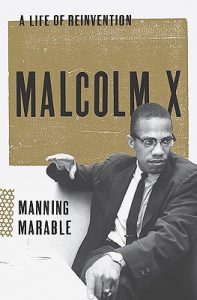 Today I’m writing about a book I’m not done reading yet, because I already know I can recommend it—especially to any Nebraskan who wants to know more than they (might have?) learned in school about Malcolm X.
Today I’m writing about a book I’m not done reading yet, because I already know I can recommend it—especially to any Nebraskan who wants to know more than they (might have?) learned in school about Malcolm X.
Manning Marable worked for years on “Malcolm X: A Life of Reinvention,” and it’s a book that combines extensive research with skillful storytelling and readability. Marable died shortly before the book was published in 2011. The book went on to win the Pulitzer Prize, and gathered both wide acclaim and bitter detraction.
It was a labor of love for Manning Marable, who was Director of Columbia University’s Institute for Research in African-American Studies (IRAAS), which is responsible for the The Malcolm X Project at Columbia University. Marable takes a more academic, yet still very readable, approach to the life of Malcolm X than the book you might already be familiar with, The Autobiography of Malcolm X, which was a collaboration between X and Alex Haley. If you’re not already familiar with that book, which came out in 1965 shortly after the death of Malcolm X, we have copies in our book club kit collection here, and it’s also recommended. It made the Nebraska 150 Books list.
Marable’s detractors fault him for being perhaps too eager to present details that the autobiography may have glossed over, enhanced, or simply left out. Each book has a different goal, to be sure, and to my mind it seems that the persona that is set forth in the autobiography was one that Marable accepted, and that he knew to be secure and strong in the minds of readers—and so his unexpected explorations are really a testament to his faith in the significance and consequence of Malcolm X as an individual. When you’ve centered so much of your professional life around someone’s legacy, as Marable did, especially when that someone is as complex as Malcolm X, appreciating and acknowledging that complexity is what separates dedication from devotion, or veneration from worship.
I can understand why such honesty might not seem refreshing, however, given the context of the current struggle for racial justice, whether it’s 1965, 2011, or 2018. There are plenty of other voices who can speak to this more eloquently and appropriately than I can. (I already have A Lie of Reinvention: Correcting Manning Marable’s Malcolm X [ed. Ball and Burroughs] checked out to read next, in order to better understand these objections.)
Of particular interest to Nebraskans, Marable’s book gives more context to the Omaha life of the family of Malcolm X than Nebraskans might know, and you’ll read disturbing details of KKK activity in Lincoln and Omaha in the early 1900s. This is a part of Nebraska history you also might not have learned about in school. To put that in some context, we’re coming up on the 100-year anniversary of the Omaha race riot of 1919, where a mob of white people stormed the Douglas County Courthouse and lynched a black man, Will Brown, awaiting trial for a crime he most likely did not commit. The mob also fatally wounded the Omaha mayor, Edward Smith. For more background on the event, see this recent addition to Nebraska Memories, and also this pdf from the Nebraska State Historical Society.
Marable, Manning. Malcolm X: A Life of Reinvention. New York: Viking, 2011. Print.
Posted in Books & Reading, General, Nebraska Memories
Tagged #FridayReads, Friday Reads, Malcolm X
1 Comment
Friday Reads: The Great British Baking Show
If you need any sort of pure happiness today or any day, watch The Great British Baking Show. Amateur bakers compete each week in various challenges from technical skill-basked tasks to creating towering “showstopper” cakes (like a shortbread clock tower). I started watching this last year or so on PBS and got hooked. It’s funny, full of beautiful pastries, and lovely people. Netflix has a few seasons now plus Masterclass (which is the two judges teaching you how to bake amazing things from the show).
So for this Friday Reads, I thought I would round up a few of the Great British Baking Show related books that I’ve started reading or adding to my bookshelf. Easy-to-follow, step-by-step recipes with lots of pictures in the cookbooks. A Baker’s Life by Paul Hollywood is more memoir/cookbook, telling his story through nostalgic recipes. Sue Perkins narrates her memoir, Spectacles, in the audio version which I’ve heard is great. Plus a coloring book!
The Great British Bake Off Big Book of Baking – Linda Collister
Mary Berry’s Baking Bible: Over 250 Classic Recipes – Mary Berry
How to Bake – Paul Hollywood
A Baker’s Life: 100 Fantastic Recipes, from Childhood Bakes to Five-Star Excellence – Paul Hollywood
Spectacles – Sue Perkins
Recipe for Life – Mary Berry

The Great British Bake Off Colouring Book – Tom Hovey (who also does all the illustrations on the show)
Friday Reads: God-Shaped Hole by Tiffanie DeBartolo
 The title for God-Shaped Hole by Tiffanie DeBartolo doesn’t make a whole lot of sense until the final pages of the book. The book doesn’t have much to do with God, so I’ll leave him out of this review.
The title for God-Shaped Hole by Tiffanie DeBartolo doesn’t make a whole lot of sense until the final pages of the book. The book doesn’t have much to do with God, so I’ll leave him out of this review.
This book is about Trixie Jordan and her quest to make sense of it all. Ever since a fortune teller told her that her one true love would die young and leave her all alone, she has felt a bit off-kilter. It’s a heavy burden for a twelve-year-old. Trixie carried the burden of her impending doom well into her thirties. Then she met Jacob Grace.
I love Jacob Grace. Throughout the book, I kept telling myself that if he truly did die between those pages, he would be reborn as my fantasy boyfriend. He would have to learn to share because I have quite a few book boyfriends. Elizabeth Bennett is not the only Mrs. Darcy.
I won’t tell you what happened to Jacob. Much of the magic and wonder of this book is contingent on the not knowing. All of life is the wonder of not knowing. Before I read this book I used to plot out every course in life before setting foot out the door. Every journey was a well-oiled machine and if a piece fell out of joint I would go home and fix it before venturing forth.
God-Shaped Hole was my first tentative step into changing my mindset. I read this book during my senior year of high school and was intrigued. At the time, I had no real concept of true love. Books were the only beau that mattered.
So I focused more on the other messages in the book. I learned that life is what you make of it. If somebody tells you your fortune, you have options:
- Become a self-fulfilling prophecy and help fate along
- Accept your fate as a possibility and take life in stride
- Take action and change your own fate
But the biggest lesson I learned was to not fear the future. Not everything in life can be planned. This bohemian wonder of a book taught me to leave my organizational structure at the door. If you spend too much time focusing on the shadowed possibilities of the future, you never see the ray of light shining through at the end of a dark tunnel.
Friday Reads : Little Beach Street Bakery
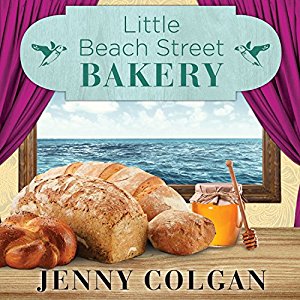 In her estimation, Polly Waterford is recovering from a failed life: a failed marketing business, a failed relationship, and being homeless. As a result, her life failures have led Polly to a small fishing village in Cornwall which is only accessible when the tide is out, and where she lives alone above an abandoned bakery, working out her frustrations by baking bread.
In her estimation, Polly Waterford is recovering from a failed life: a failed marketing business, a failed relationship, and being homeless. As a result, her life failures have led Polly to a small fishing village in Cornwall which is only accessible when the tide is out, and where she lives alone above an abandoned bakery, working out her frustrations by baking bread.
Her bread baking as an emotional release quickly becomes a passion, each loaf better than the last. Soon, Polly is experimenting with nuts and seeds, olives and chorizo, and the local honey–courtesy of a handsome local beekeeper with issues of his own. With help from old friends and new, a puffin named Neil, and her amazing bread making skills, Polly builds a new life for herself.
There are three books in the Little Beach Street Bakery Series, by Jenny Colgan: Little Beach Street Bakery, Summer at Little Beach Street Bakery, and Christmas at Little Beach Street Bakery. I listened to the first one, was immediately hooked, and then listened to the other two immediately. I found the story location especially unique, the characters real and well developed, and the desire to bake bread overwhelming! Enjoy!
Friday reads: The Shepherd, the Angel, and Walter the Christmas Miracle Dog by Dave Barry
 Stressed out by the festive season? Need a light read? A Dave Barry book might be just what the doctor ordered. And if it’s holiday-themed, all the better. The Shepherd, the Angel, and Walter the Christmas Miracle Dog was a gift from my sister to add to my collection of annual reading. It’s about Doug Barnes, an adolescent boy in the ‘60s with a family and a beloved dog named Frank. Frank is quite elderly, and Doug’s mom and dad have already started the conversation about the difficult and inevitable loss that lies ahead.
Stressed out by the festive season? Need a light read? A Dave Barry book might be just what the doctor ordered. And if it’s holiday-themed, all the better. The Shepherd, the Angel, and Walter the Christmas Miracle Dog was a gift from my sister to add to my collection of annual reading. It’s about Doug Barnes, an adolescent boy in the ‘60s with a family and a beloved dog named Frank. Frank is quite elderly, and Doug’s mom and dad have already started the conversation about the difficult and inevitable loss that lies ahead.
The story takes place during Christmas, when the annual pageant at St. John’s Episcopal Church is pressing upon Doug and his sister Becky. On a bitter Christmas Eve, a call to beckon Frank from the backyard does not yield a result. How will the family break the news to Becky, who is cast in the host of angels? How will Doug, who made the discovery, rise to the occasion of helping his parents? And how will the family deal with this sadness when everyone is due at the church in a few hours to perform their roles without tear stained faces?
Enter a cast of characters and a rescue dog named Walter. While the topic of pet-loss may not seem to lend itself to a holiday read, remember–this story is told by Dave Barry, who wields a pen to blend both levity and poignancy to produce a smile with a few tears or maybe even some laughter. Also remember that the word “miracle” appears in the title. That may help you decide this short read might be worth your time.
Navigating the holidays often includes a long list of things to do, and for many of us the lack of light can make the endless treadmill of tasks more exhausting. Sitting still with someone else’s story, true or imagined, may help you take a quick and necessary respite.
Barry, Dave. The Shepherd, the Angel, and Walter the Christmas Miracle Dog. G.P. Putnam’s Sons, 2006.







